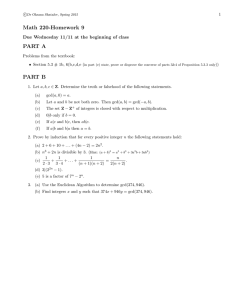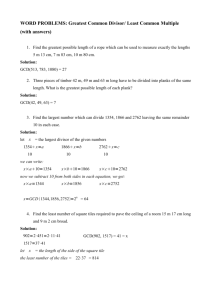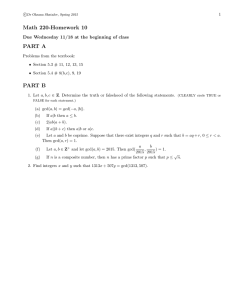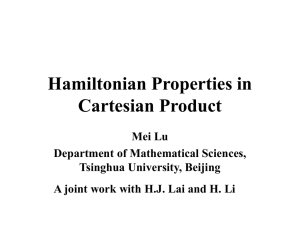Hamiltonian cycles in torical lattices Vladimir K. Leontiev EuroComb 2005
advertisement
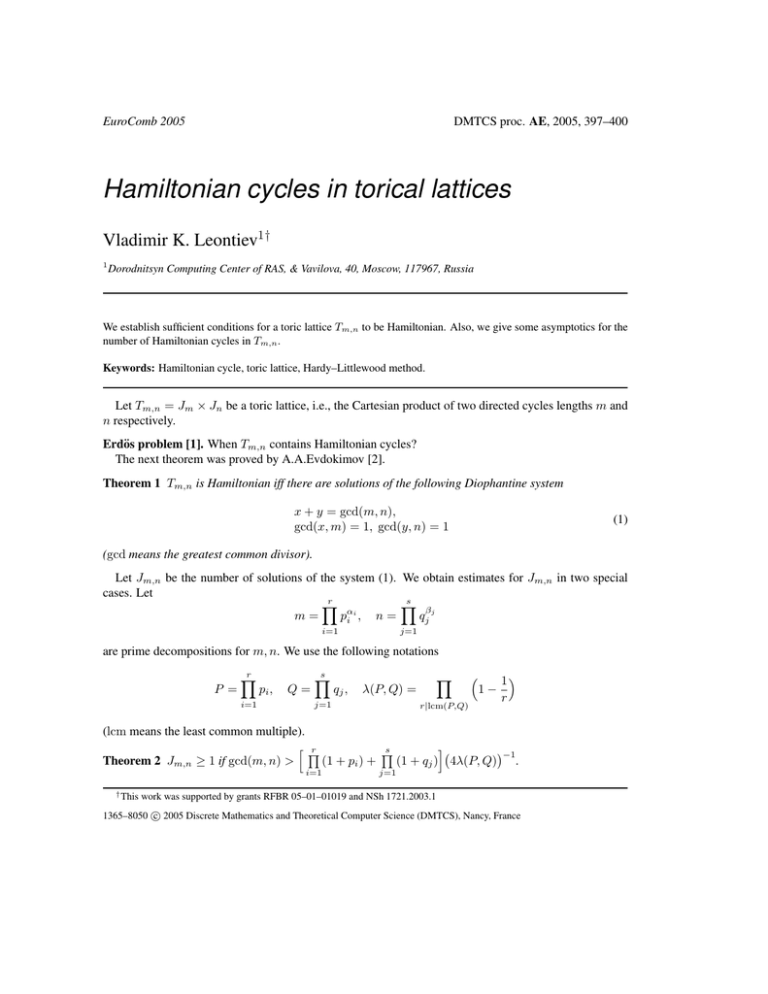
DMTCS proc. AE, 2005, 397–400 EuroComb 2005 Hamiltonian cycles in torical lattices Vladimir K. Leontiev1† 1 Dorodnitsyn Computing Center of RAS, & Vavilova, 40, Moscow, 117967, Russia We establish sufficient conditions for a toric lattice Tm,n to be Hamiltonian. Also, we give some asymptotics for the number of Hamiltonian cycles in Tm,n . Keywords: Hamiltonian cycle, toric lattice, Hardy–Littlewood method. Let Tm,n = Jm × Jn be a toric lattice, i.e., the Cartesian product of two directed cycles lengths m and n respectively. Erdös problem [1]. When Tm,n contains Hamiltonian cycles? The next theorem was proved by A.A.Evdokimov [2]. Theorem 1 Tm,n is Hamiltonian iff there are solutions of the following Diophantine system x + y = gcd(m, n), gcd(x, m) = 1, gcd(y, n) = 1 (1) (gcd means the greatest common divisor). Let Jm,n be the number of solutions of the system (1). We obtain estimates for Jm,n in two special cases. Let r s Y Y β i m= pα , n = qj j i i=1 j=1 are prime decompositions for m, n. We use the following notations P = r Y i=1 pi , Q= s Y qj , Y λ(P, Q) = j=1 r|lcm(P,Q) 1− 1 r (lcm means the least common multiple). hQ i r s −1 Q Theorem 2 Jm,n ≥ 1 if gcd(m, n) > (1 + pi ) + (1 + qj ) 4λ(P, Q) . i=1 † This j=1 work was supported by grants RFBR 05–01–01019 and NSh 1721.2003.1 c 2005 Discrete Mathematics and Theoretical Computer Science (DMTCS), Nancy, France 1365–8050 398 Vladimir K. Leontiev The proofs of the theorems 1, 2 are based on the following analytic and combinatorial results. Let X αk 1 JN (u) = u a , N = pα 1 . . . pk . (a,N )=1 k X k X 1 1 Lemma 1 JN (u) = + − 1 − u i=1 1 − upi 1 − ... 1 − upi pj 1≤i<j≤k This formula can be easily proved by inclusion - exclusion principle. Let Sr (m, n) be the number of solutions of the system x + y = r, gcd(x, m) = 1, gcd(y, n) = 1. (2) The generating function for Sr (m, n) is related with Jn (u) by the following formula. Lemma 2 ∞ X Sr (m, n)ur = Jm (u)Jn (u). (3) r=1 Formula (3) implies an expression for the number of solutions of the system (1). Lemma 3 Let N = gcd(m, n) + 1. Then the following equation holds Jm,n = gcd(m, n) X u|P, v|Q µ(u)µ(v) + lcm(u, v) X u|P, v|Q X u|P, v|Q µ(u)µ(v)(u + v) + 2 lcm(u, v) µ(u) X 1 + u αu =1 αN −1 (αv − 1) X u|P, v|Q µ(v) X 1 . (4) v αv =1 αN −1 (αu − 1) In sums of type 1 X αu =1 αN −1 (αv − 1) (5) the summation is over those roots of equation αu = 1 that are not the roots of equation αv = 1. Sums (5) are called Dedekind sums. They are well-known in combinatorial analysis (e.g., see [3]). To simplify (4) we use identities about Möbius function. They are 2-dimensional analogues of the classical formula X µ(d) Y 1 = 1− . d p d|n p|n An example of these identities is given by the following Lemma. X µ(u)µ(v) Y 1 Lemma 4 ([4]) = 1− . lcm(u, v) r u|m, v|n r|lcm(P,Q) 399 Hamiltonian cycles in torical lattices Dealing with Dedekind sums (5) we use the following useful statement. Let Sn (a) = X αb =1 1 , αn (αa − 1) (6) where summation is over those roots of equation xb = 1 that are not the roots of equation xa = 1. By m0 we denote the smallest positive solution of equation ax ≡ −(n + a) (mod b). Let w(a, b) = m0 − 1. Lemma 5 Sn (a) = b gcd(a, b) − − w(a, b). 2 2 lcm(a, b) (7) References [1] Trotter W.T., Erdös P. When the cartesian product of directed cycles is hamiltonian. J. Graph Theory. V.2, 1978. P. 137–142. [2] Evdokimov A.A. Numeration of subsets of a finite set. (In Russian) Metody Diskret. Analiz. V. 34, 1980. P. 8–26. [3] Ira M. Gessel. Generating functions and generalized Dedekind sums. The electronic Journal of Combinatorics. V. 4, no. 2, 1997. [4] Leontiev V.K. Hamiltonian cycles in toric lattices. (In Russian) DAN, V. 395, no 5, 2004. P. 590–591. 400 Vladimir K. Leontiev


